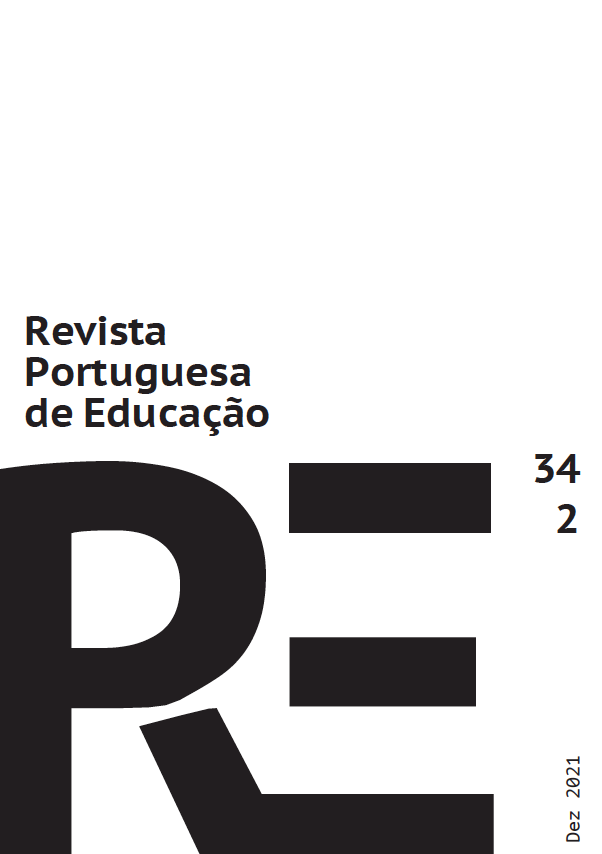Exergames como una alternativa pedagógica motivadora en las clases de Educación Física: Una revisión integrativa
DOI:
https://doi.org/10.21814/rpe.18074Palabras clave:
Aprendizagem motora, Pessoa com deficiência, Inclusão educacional, Jogo digital, Revisão integrativaResumen
Esta revisión integradora de la literatura tuvo como objetivo analizar los juegos de ejercicios como una posibilidad de recurso pedagógico motivador para incrementar la práctica de ejercicios físicos y el gasto energético en las clases de Educación Física. Los descriptores “Educación Física”, “ejercicio”, “videojuegos”, “juegos electrónicos”, “inclusión” se utilizaron en las bases de datos electrónicas MedLine (via PubMed), ERIC, Scopus, SciELO, Redalyc, Campbell Collaboration y Google Scholar. Se incluyeron 16 artículos originales, indexados por Qualis Periódicos (nueve en portugués y siete en inglés), categorizados en juegos de ejercicios y la influencia motivadora; juegos de ejercicios y gasto energético; juegos de ejercicios y estudiantes con discapacidades. Los resultados indicaron que el uso de juegos de ejercicios como intervención puede ser una alternativa pedagógica motivadora y una herramienta para incrementar el gasto energético en la práctica de ejercicios físicos en las clases de Educación Física, ya que engloban el movimiento corporal combinado con la alegría y la incitación, siendo bien aceptado por estudiantes sin o con discapacidades. Se entiende que el carácter divertido que presentan los juegos de ejercicios puede ser un dispositivo facilitador. El mundo fantasioso creado por la alegría de los juegos digitales, que requieren actividad física, permite aumentar el gasto energético y colaborar en el aprendizaje y el desarrollo motor.
Descargas
Citas
Almeida, M. E., & Silva, M. G. M. (2011). Currículo, tecnologia e cultura digital: espaços e tempos de web currículo. Revista e-curriculum, 7(1), 1-19.
Alves, L., & Carvalho, A. M. (2011). Videogame: é do bem ou do mal? Como orientar pais. Psicologia em Estudo, 16(2), 251-258. https://doi.org/10.1590/S1413-73722011000200008
Araújo, B. M. R., Freitas, C. M. S. M., Caminha, I. O., & Silva, P. P. C. (2011). Virtualização esportiva e os novos paradigmas para o movimento humano. Motriz, 17(4), 600-609. https://doi.org/10.1590/S1980-65742011000400004
Baracho, A. F. O., Gripp F. J., & Lima, M. (2012). Os exergames e a educação física escolar na cultura digital. Revista Brasileira de Ciências do Esporte, 34(1), 111-126. https://doi.org/10.1590/S0101-32892012000100009
Bekker, T., Sturm, J., & Eggen, B. (2010). Designing playful interactions for social interaction and physical play. Personal and Ubiquitous Computing, 14(5), 385-396. https://doi.org/10.1007/s00779-009-0264-1
Brasil (2016). Ministério da Educação. Secretaria Municipal de Educação. Orientações Curriculares: Educação Física. MEC/SME.
Brasil (2018). Ministério da Educação. Conselho Nacional de Secretários de Educação. Base Nacional Comum Curricular (BNCC). MEC/CONSED.
Brasil (2019). Lei Municipal nº 6.577, de 28 de maio de 2019. Dispõe sobre a prática de Educação Física Adaptada. Câmara Municipal do Rio de Janeiro.
Costa, M. A. F., Santos, C. B. M., & Xavier, G. A. (2015). Os games como possibilidade: que história é essa? Educação Básica Revista, 1(1), 107-124.
Cruz Junior, G. (2017). Vivendo o jogo ou jogando a vida? Notas sobre jogos (digitais) e educação em meio à cultura ludificada. Revista Brasileira de Ciências do Esporte, 39(3), 226-232. https://doi.org/10.1016/j.rbce.2017.02.012
D’Avila, O. P., Pinto, L. F. S., Hauser, L., Gonçalves, M. R., & Harzheim, E. (2017). O uso do Primary Care Assessment Tool (PCAT): Uma revisão integrativa e proposta de atualização. Ciência & Saúde Coletiva, 22(3), 855-865. https://doi.org/10.1590/1413-81232017223.03312016
Dill, K. (2013). The Oxford handbook of media psychology. Oxford University Press.
Dionísia, J. L., & Ventura, A. F. (2016). Exergame: interação entre games e crianças portadoras de paralisia cerebral. Revista Tecnológica da FATEC de Americana, 3(2), 39-57.
Di Tore, S., D’Elia, F., Aiello, P., Carlomagno, N., & Sibilio, M. (2012). Didactics, movement and technology: new frontiers of the human-machine interaction. Journal of Human Sport and Exercise, 7(1), 178-184. https://doi.org/10.4100/jhse.2012.7.Proc1.20
Enes, C. C., & Slater, B. (2010). Obesidade na adolescência e seus principais fatores determinantes. Revista Brasileira de Epidemiologia, 13(1), 163-171. https://doi.org/10.1590/S1415-790X2010000100015
Fardo, M. L. (2013). A gamificação aplicada em ambientes de aprendiza-gem. Novas Tecnologias na Educação, 11(1), 1-9. https://doi.org/10.22456/1679-1916.41629
Finco, M. D., & Fraga, A. B. (2012). Rompendo fronteiras na Educação Física através dos videogames com interação corporal. Motriz, 18(3), 533-541. https://doi.org/10.1590/S1980-65742012000300014
Finco, M. D., & Fraga, A. B. (2013). Corpo joystick: cinema, videogames e estilo de vida ativo. Licere, 16(3), 1-19.
Finco, M. D., Reategui, E. B., & Zaro, M. A. (2015). Laboratório de exergames: um espaço complementar para as aulas de educação física. Movimento, 21(3), 687-699. https://doi.org/10.22456/1982-8918.52435
Fogel, V., Miltenberger, R., Graves, R., & Koehler, S. (2010). The effects of exergaming on physical activity among inactive children in a physical education classroom. Journal of Applied Behavior Analysis, 43(4), 591-600. https://doi.org/10.1901/jaba.2010.43-591
Gao, Z., Hannan, P., Xiang, P., Stodden, D., & Valdez, V. (2013). Video game-based exercise, Latino children’s physical health, and academic achievement. American Journal of Preventive Medicine, 44(3), 240-246. https://doi.org/10.1016/j.amepre.2012.11.023
Graves, L., Ridgers, N., & Stratton, G. (2008). The contribution of upper limb and total body movement to adolescents’ energy expenditure whilst playing Nintendo Wii. European Journal of Applied Physiology, 104(4), 617-623. https://doi.org/10.1007/s00421-008-0813-8
Graves, L., Stratton, G., Ridgers, N., & Cable, N. (2008). Energy expenditure in adolescents playing new generation computer games. British Journal of Sports Medicine, 42(7), 592-594. https://doi.org/10.1136/bmj.39469.677685.AD
Grübel, J. M., & Bez, M. R. (2006). Jogos Educativos. Novas Tecnologias na Educação, 4(2), 1-7.
Höysniemi, J. (2006). Design and evaluation of physically interactive video games [Unpublished doctoral dissertation]. University of Tampere, Finland.
Huizinga, J. (2014). Homo Ludens: O jogo como elemento da cultura (8.ª edição). Perspectiva.
Lanningham-Foster, L., Foster, R., McCrady, S., Jensen, T., Mitre, N., & Levine, J. (2009). Activity promoting video games and increased energy expenditure. The Journal of Pediatrics, 154(6), 819-823. https://doi.org/10.1016/j.jpeds.2009.01.009
Leite, M. C. D., & León, M. E. S. (2018). Tecnologia assistiva e neurodegeneração: estimulação cognitiva com jogos digitais. Revista CCEI – URCAMP, 23(38), 61-78. https://doi.org/10.30945/cceiv23i38.343
Lieberman, D., Chamberlin, B., Medina Jr., E., Franklin, B., McHugh, S. B., & Vafiadis, D. K. (2011). The power of play: Innovations in Getting Active Summit 2011: a science panel proceedings report from the American Heart Association. Circulation, 123(21), 2507-2516. https://doi.org/10.1161/CIR.0b013e318219661d
Lwin, M., & Malik, S. (2014). Can exergames impart health messages? Game play, framing and drivers of physical activity among children. Journal of Health Communication, 19(2), 136-151. https://doi.org/10.1080/10810730.2013.798372
Maia, M. V. C. M., Julião, D. B., & Silva, M. C. (2014). Elas não querem só carteiras: reflexões sobre o aprisionamento do corpo na Educação Básica, p. 145. In: Maia, M. V. C. M. Criar e brincar: o lúdico no processo de ensino e aprendizagem. Wak.
Marchetti, P. H., Luz Junior, D. A., Belmiro, W. O., Preto, W., Xavier, M. V. S., Teixeira, L. F. M., & Uchida, M. C. (2011). Jogos eletrônicos interativos Exergaming: uma breve revisão sobre suas aplicações na Educação Física. Revista Pulsar, 3(1), 1-13.
Medeiros, P., Santos, J. O. L., Capistrano, R., Carvalho, H. P., Beltrame, T. S., & Cardoso, F. L. (2018). Efeitos dos exergames em crianças com risco e dificuldade significativa de movimento: um estudo cego randomizado. Revista Brasileira de Ciências do Esporte, 40(1), 87-93. https://doi.org/10.1016/j.rbce.2018.01.005
Moita, F. (2007). Game on: jogos eletrônicos na escola e na vida da geração @. Alínea.
Patel, V., Yoskowitz, N., Arocha, J., & Shortliffe, E. (2009). Cognitive and learning sciences in biomedical and health instructional design: A review with lessons for biomedical informatics education. Journal of Biomedical Informatics, 42(1), 176-197. https://doi.org/10.1016/j.jbi.2008.12.002
Pereira, S. A., Lago, F., Melo, L. S., Moran, C. A., & Baroni, M. P. (2013). Uso do Nintendo® Wii e adaptações cardiorrespiratórias agudas em uma criança com Síndrome de Down: relato de caso. ASSOBRAFIR Ciência, 4(3), 45-50. http://dx.doi.org/10.47066/2177-9333/ac.14957
Perez, C., Neiva, J., & Monteiro, C. (2014). A vivência da tarefa motora em ambiente virtual e real: estudo da devolução do saque do tênis de mesa. Pensar a Prática, 17(1), 191-199.
Quinn, M. (2013). Introduction of Active Video Gaming into the middle school curriculum as a school-based childhood obesity intervention. Journal of Health Care, 27(1), 3-12. https://doi.org/10.1016/j.pedhc.2011.03.011
Quiroga, M. A., Herranz, M., Gómez-Abad, M., Kebir, M., Ruiz, J., & Colom, R. (2009). Video-games: do they require general intelligence? Computers and Education, 53(2), 414-418. https://doi.org/10.1016/j.compedu.2009.02.017
Retondar, J. (2011). O jogo como conteúdo de ensino na perspectiva dos estudos do imaginário social. Revista Brasileira de Ciências do Esporte, 33(2), 413-426. https://doi.org/10.1590/S0101-32892011000200009
Richter, A. C., Gonçalves, M. C., & Vaz, A. F. (2011). Considerações sobre a presença do esporte na Educação Física infantil: reflexões e experiências. Educar em Revista, 41, 181-195. https://doi.org/10.1590/S0104-40602011000300012
Santos, J., Pádua, A., Paraizo, M., & Campos, D. (2013). Utilização do Nintendo Wii como recurso incentivador de atividade física em crianças com Síndrome de Down: estudo de caso. Ensaios e Ciência: Ciências Biológicas, Agrárias e da Saúde, 17(1), 61-77.
Santos, M. P., & Fonseca, M. (2011). Do desejável e do real: culturas de inclusão ou de exclusão na formação de futuros professores de Educação Física? Revista Teias, 12(24), 135-158.
Sgrò, F., Schembri, R., Nicolosi, S., Barresi, M., & Lipoma, M. (2013). Exergames for Physical Education: an overview about interaction design perspectives. Word Journal on Education Technology, 5(2), 248-256.
Shayne, R., Fogel, V., Miltenberger, R., & Koehler, S. (2012). The effects of exergaming on physical activity in a third-grade physical education class. Journal of Applied Behavior Analysis, 45(1), 211-215. https://doi.org/10.1901/jaba.2012.45-211
Sinclair, J., Hingston, P., & Masek, M. (2007). Considerations for the design of exergames. In Proceedings of the 5th international conference on Computer graphics and interactive techniques in Australia and Southeast Asia (GRAPHITE '07) (pp. 289–295). https://doi.org/10.1145/1321261.1321313
Souza, M. T., Silva, M. D., & Carvalho, R. (2010). Integrative review: What is it? How to do it? Einstein, 8(1), 102-106. https://doi.org/10.1590/s1679-45082010rw1134
Sun, H. (2012). Exergaming impact on physical activity and interest in elementary school children. Research Quarterly for Exercise and Sport, 83(2), 212-220. https://doi.org/10.1080/02701367.2012.10599852
Vaghetti, C. A. O., & Botelho, S. S. C. (2010). Ambientes virtuais de apren¬dizagem na educação física: uma revisão sobre a utilização dos exergames. Ciência e Cognição, 15(1), 76-88.
Descargas
Publicado
Versiones
- 2022-01-08 (2)
- 2021-12-30 (1)
Cómo citar
Número
Sección
Licencia
Derechos de autor 2021 Revista Portuguesa de Educação

Esta obra está bajo una licencia internacional Creative Commons Atribución-CompartirIgual 4.0.
1. Los autores y autoras conservan los derechos de autor y conceden a la revista el derecho de la primera publicación, con el trabajo simultáneamente disponible bajo la Licencia Creative Commons Attribution que permite compartir el trabajo con el reconocimiento de la autoría y publicación inicial en esta revista.
2. Los autores y autoras pueden asumir contratos adicionales separadamente para la distribución no exclusiva de la versión del trabajo publicada en esta revista (por ejemplo, depositar en un repositorio institucional o como capítulo de libro), con el reconocimiento de la autoría y publicación inicial en esta revista.
3. Los autores y autoras están autorizados y son incitados/as a publicar y compartir su trabajo en línea (por ejemplo, en repositorios institucionales o páginas personales) antes o durante el proceso editorial, pues puede dar lugar a modificaciones productivas o aumentar el impacto y las citas del trabajo publicado (Véase El Efecto del Acceso Libre).
Esta obra está disponible bajo la Licencia Creative Commons Atribución-CompartirIgual 4.0.




















